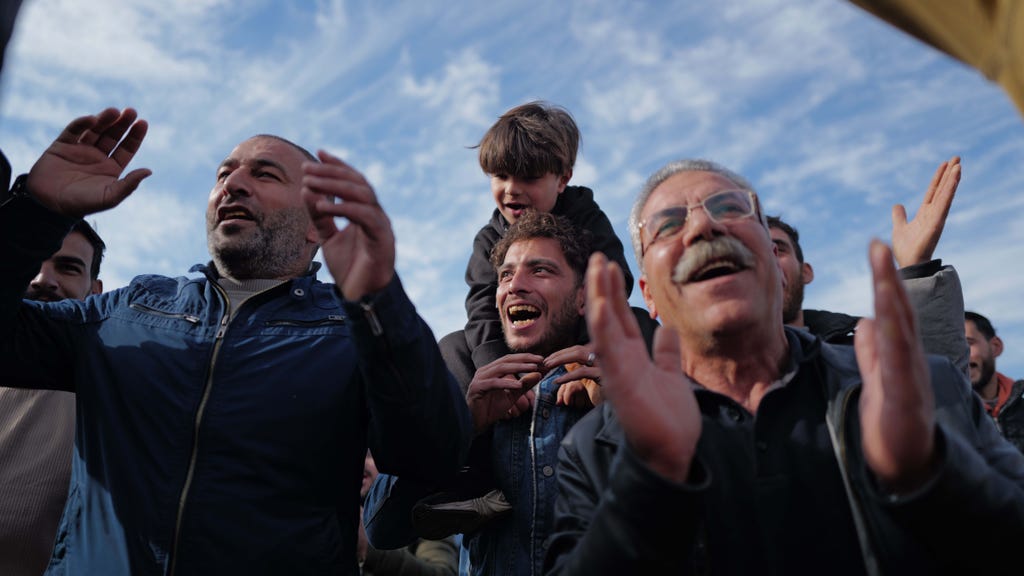The Elation of Return: Syrian Refugees Celebrate the Prospect of Going Home
The air crackles with an electric energy, a symphony of car horns and joyous shouts echoing through the normally tense border crossing between Syria and Lebanon. Spontaneous bursts of song erupt from the gathered crowds, a vibrant testament to the wave of hope sweeping over Syrian refugees who, after years of displacement, are finally glimpsing the possibility of returning home. This unprecedented celebratory atmosphere marks a profound shift in the narrative of the Syrian refugee crisis, a story long dominated by images of suffering, loss, and uncertainty. The scene at the border is a powerful visualization of the deep-seated longing for home, a yearning intensified by years of exile and the hardships endured in foreign lands. For many, this isn’t just a return to a physical place; it’s a return to a sense of belonging, identity, and a reclamation of their stolen lives.
Yusef Hamad, his face radiant with uncontainable joy, perfectly embodies this collective sentiment. The early morning phone call from his cousin, bearing the simple yet momentous news – "It’s over, we’re returning" – ignited a spark of hope that had long been dormant. The weight of years of exile lifted in an instant, replaced by an overwhelming surge of happiness. His story, echoed in the countless faces illuminating the border crossing, speaks to the profound emotional impact of this potential repatriation. The prospect of returning home, of rebuilding lives shattered by conflict, represents not just an end to their displacement, but a new beginning, a chance to heal and reclaim their futures.
The Complex Realities of Repatriation: Weighing Hope Against Uncertainty
While the scenes of jubilation paint a vivid picture of hope, the reality of returning to Syria remains complex and fraught with challenges. The years of conflict have left deep scars on the country’s landscape, both physical and societal. Homes have been destroyed, infrastructure decimated, and the economy crippled. The security situation in many areas remains precarious, with lingering pockets of violence and the threat of renewed conflict. Beyond these immediate concerns lie deeper, more intricate challenges, including the psychological trauma endured by both those who fled and those who remained, the fragmentation of communities, and the complex process of rebuilding social cohesion.
The decision to return is a deeply personal one, weighed against a backdrop of these formidable obstacles. For some, the pull of home, the yearning to rebuild their lives on their own land, outweighs the risks. For others, the uncertainties are too great, the scars of the past too deep. The decision is further complicated by the varying circumstances faced by individual refugees. Some have maintained stronger ties to their home communities, while others have established new lives and roots in their host countries. The availability of resources, the level of destruction in their home areas, and the support available for resettlement all play crucial roles in shaping their choices.
Navigating the Path Forward: Addressing the Needs of Returning Refugees
The potential large-scale return of refugees presents both opportunities and challenges for Syria and the international community. It necessitates a comprehensive and coordinated approach to facilitate a safe, dignified, and sustainable repatriation process. Crucial to this effort is addressing the immediate needs of returning refugees, including providing access to shelter, food, healthcare, and education. Rebuilding damaged infrastructure, revitalizing the economy, and creating employment opportunities are essential for long-term stability and to prevent a renewed cycle of displacement.
Equally important is addressing the root causes of the conflict, promoting reconciliation, and fostering a climate of trust and coexistence. This requires engaging all stakeholders, including the Syrian government, civil society organizations, and the international community, in a constructive dialogue and collaborative effort. Justice and accountability for past atrocities are crucial for healing and preventing future conflicts. Furthermore, addressing the underlying political and socio-economic grievances that fueled the initial uprising is essential for creating a truly sustainable peace.
The Uncertain Future: Balancing Hope and Pragmatism
The scenes of celebration at the border offer a glimpse of hope in a region long overshadowed by conflict and displacement. The possibility of returning home, of rebuilding lives and communities, represents a significant turning point in the Syrian refugee crisis. However, the path forward is fraught with challenges, and the success of repatriation efforts hinges on a multifaceted and sustained commitment from all stakeholders. The international community must play a vital role in supporting the Syrian government and civil society organizations in addressing the complex needs of returning refugees and creating conditions conducive to sustainable peace.
While the scenes of jubilation are a powerful testament to the resilience of the human spirit and the enduring power of hope, it’s crucial to approach the prospect of large-scale repatriation with a balanced perspective, acknowledging both the opportunities and the significant challenges that lie ahead. The international community’s commitment to providing sustained support and resources will be critical in determining whether this moment of hope translates into a genuine and lasting solution for the Syrian people and the region as a whole. Only through a collaborative and comprehensive approach can the dream of returning home become a sustainable reality for the millions of Syrians who have endured the hardships of displacement and long for a peaceful and prosperous future.














